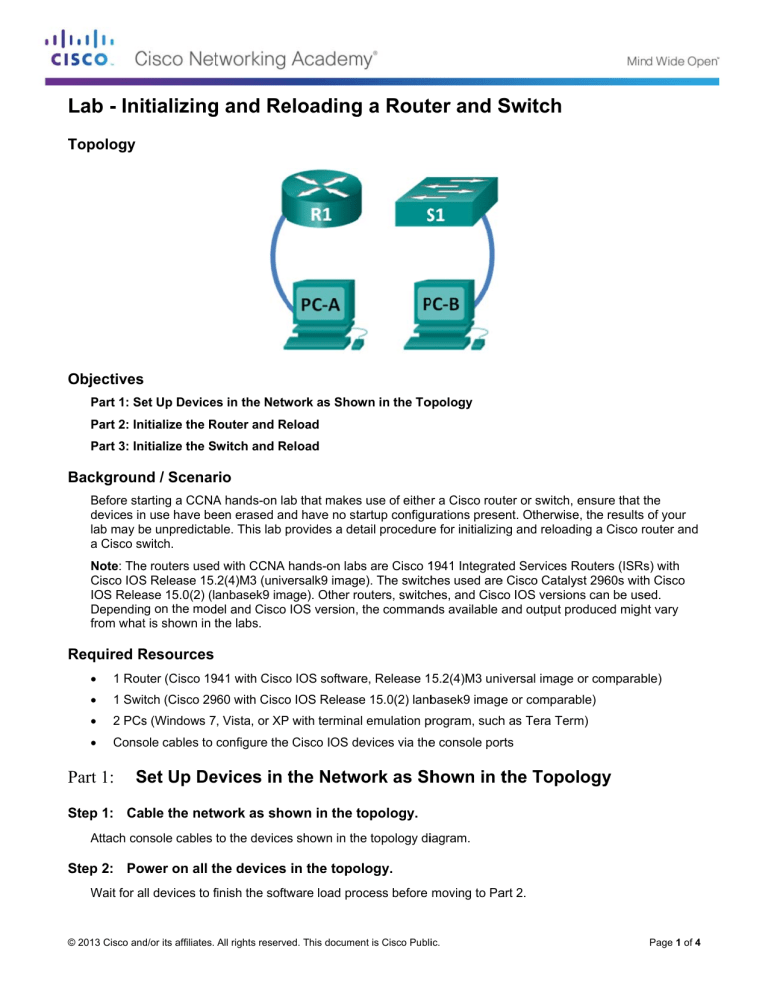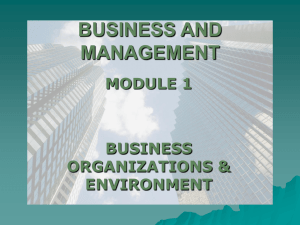
L Lab - Initializing g and Re eloading g a Routter and S Switch T Topology O Objectives Part 1: Se et Up Device es in the Netw work as Show wn in the To opology Part 2: Initialize the Router R and Reload Part 3: Initialize the Switch S and Reload B Backgroun nd / Scenarrio Before sta arting a CCNA A hands-on la ab that makes s use of eithe r a Cisco router or switch, ensure that tthe devices in n use have be een erased an nd have no sttartup configu urations prese ent. Otherwise e, the results of your lab may be b unpredictab ble. This lab provides p a de etail procedure e for initializin ng and reload ding a Cisco router and a Cisco sw witch. Note: The e routers used d with CCNA hands-on lab bs are Cisco 1 1941 Integrate ed Services R Routers (ISRss) with Cisco IOS S Release 15..2(4)M3 (univ versalk9 image). The switch hes used are e Cisco Catalyyst 2960s with h Cisco IOS Relea ase 15.0(2) (lanbasek9 ima age). Other ro outers, switch hes, and Ciscco IOS version ns can be use ed. Depending on the mod del and Cisco IOS version, the comman nds available a and output prroduced migh ht vary from whatt is shown in the t labs. R Required Resources R 1 Rou uter (Cisco 19 941 with Cisco o IOS softwarre, Release 1 5.2(4)M3 universal image or comparab ble) 1 Switch (Cisco 29 960 with Cisco o IOS Release 15.0(2) lanb basek9 image e or compara able) 2 PCs s (Windows 7, 7 Vista, or XP P with termina al emulation p program, such h as Tera Term) Conso ole cables to configure the e Cisco IOS devices via the e console porrts P Part 1: Set S Up De evices in the Netw work as Sh hown in tthe Topo ology S Step 1: Ca able the netw work as sho own in the topology. t Attach console cables to the devices shown in th he topology diiagram. S Step 2: Po ower on all the t devices in the topo ology. Wait for all a devices to finish f the softw ware load pro ocess before moving to Pa art 2. © 2013 Cisco and d/or its affiliates. All rights reserve ed. This docume ent is Cisco Publiic. Page 1 of 4 Initializing and Reloading a Router and Switch Part 2: Initialize the Router and Reload Step 1: Connect to the router. Console into the router and enter privileged EXEC mode using the enable command. Router> enable Router# Step 2: Erase the startup configuration file from NVRAM. Type the erase startup-config command to remove the startup configuration from nonvolatile randomaccess memory (NVRAM). Router# erase startup-config Erasing the nvram filesystem will remove all configuration files! Continue? [confirm] [OK] Erase of nvram: complete Router# Step 3: Reload the router. Issue the reload command to remove an old configuration from memory. When prompted to Proceed with reload, press Enter to confirm the reload. Pressing any other key will abort the reload. Router# reload Proceed with reload? [confirm] *Nov 29 18:28:09.923: %SYS-5-RELOAD: Reload requested by console. Reload Reason: Reload Command. Note: You may receive a prompt to save the running configuration prior to reloading the router. Respond by typing no and press Enter. System configuration has been modified. Save? [yes/no]: no Step 4: Bypass the initial configuration dialog. After the router reloads, you are prompted to enter the initial configuration dialog. Enter no and press Enter. Would you like to enter the initial configuration dialog? [yes/no]: no Step 5: Terminate the autoinstall program. You will be prompted to terminate the autoinstall program. Respond yes and then press Enter. Would you like to terminate autoinstall? [yes]: yes Router> Part 3: Initialize the Switch and Reload Step 1: Connect to the switch. Console into the switch and enter privileged EXEC mode. Switch> enable Switch# © 2013 Cisco and/or its affiliates. All rights reserved. This document is Cisco Public. Page 2 of 4 Initializing and Reloading a Router and Switch Step 2: Determine if there have been any virtual local-area networks (VLANs) created. Use the show flash command to determine if any VLANs have been created on the switch. Switch# show flash Directory of flash:/ 2 3 4 5 6 -rwx -rwx -rwx -rwx -rwx 1919 1632 13336 11607161 616 Mar Mar Mar Mar Mar 1 1 1 1 1 1993 1993 1993 1993 1993 00:06:33 00:06:33 00:06:33 02:37:06 00:07:13 +00:00 +00:00 +00:00 +00:00 +00:00 private-config.text config.text multiple-fs c2960-lanbasek9-mz.150-2.SE.bin vlan.dat 32514048 bytes total (20886528 bytes free) Switch# Step 3: Delete the VLAN file. a. If the vlan.dat file was found in flash, then delete this file. Switch# delete vlan.dat Delete filename [vlan.dat]? You will be prompted to verify the file name. At this point, you can change the file name or just press Enter if you have entered the name correctly. b. When you are prompted to delete this file, press Enter to confirm the deletion. (Pressing any other key will abort the deletion.) Delete flash:/vlan.dat? [confirm] Switch# Step 4: Erase the startup configuration file. Use the erase startup-config command to erase the startup configuration file from NVRAM. When you are prompted to remove the configuration file, press Enter to confirm the erase. (Pressing any other key will abort the operation.) Switch# erase startup-config Erasing the nvram filesystem will remove all configuration files! Continue? [confirm] [OK] Erase of nvram: complete Switch# Step 5: Reload the switch. Reload the switch to remove any old configuration information from memory. When you are prompted to reload the switch, press Enter to proceed with the reload. (Pressing any other key will abort the reload.) Switch# reload Proceed with reload? [confirm] Note: You may receive a prompt to save the running configuration prior to reloading the switch. Type no and press Enter. System configuration has been modified. Save? [yes/no]: no © 2013 Cisco and/or its affiliates. All rights reserved. This document is Cisco Public. Page 3 of 4 Initializing and Reloading a Router and Switch Step 6: Bypass the initial configuration dialog. After the switch reloads, you should see a prompt to enter the initial configuration dialog. Type no at the prompt and press Enter. Would you like to enter the initial configuration dialog? [yes/no]: no Switch> Reflection 1. Why is it necessary to erase the startup configuration before reloading the router? 2. You find a couple configurations issues after saving the running configuration to the startup configuration, so you make the necessary changes to fix those issues. If you were to reload the device now, what configuration would be restored to the device after the reload? © 2013 Cisco and/or its affiliates. All rights reserved. This document is Cisco Public. Page 4 of 4





